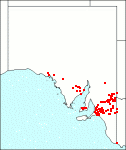|
Olearia passerinoides
Citation:
Benth., Fl. Aust. 3:482 (1867).
Synonymy: Diplopappus passerinoides Turcz., Bull. Soc. Nat. Mosc. 24:62 (1851); Aster vernicosus F. Muell., Fragm. Phyt. Aust. 5:67 (1865); O. toppii Ewart & Jean White, Proc. R. Soc. Vic. 21:543, t. 31 (1909); O. hookeri sensu J. Black, Fl. S. Aust. 871 (1957), non Benth.
Common name: None
Description:
Glutinous shrub to 2.5 m high; stems erect, woody, much-branched, glabrous, without ribs; leaves sessile, erect to patent, linear, attenuate at the base, obtuse, 4-20 mm long, to 1 mm wide, glabrous, green, concolorous, compressed-terete, slightly concave above, convex below; margins entire.
Capitula terminal, solitary or in dense corymbs of 2-8 on short branched peduncles with few reduced leaves; involucre campanulate, 5-6 mm long; bracts 3-4-seriate, linear, acute, pallid, green near the apex, glabrous; ray florets 6-15; ligules linear, 4-10 mm long, white (rarely pale-pink); disk florets 10-14, mauve to pink.
Achenes terete, 1.5-2 mm long, striate, pubescent; pappus bristles 25-40, 3-4 mm long, subequal or a few shorter ones in an outer series.
Published illustration:
Blackall & Grieve (1975) How to know Western Australian wildflowers, 4:789.
|
Conservation status:
native
Flowering time: No flowering time is available |

SA Distribution Map based
on current data relating to
specimens held in the
State Herbarium of South Australia
|
Biology:
No text
Author:
Not yet available
|

